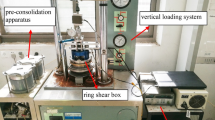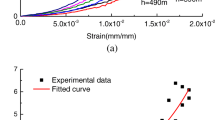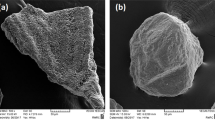Abstract
The preserved area of snail fossils, with layers of up to 10 m deep, in the lignite coal mining area of Mae Moh in northern Thailand has been set aside; however, there is concern about the impact of weathering and erosion in the long term due to the breakage and low strength of snail fossils. Therefore, the present study aims to investigate the strength properties of the snail fossils in association with the effect of particle breakage using a direct simple shear test. Disturbed snail fossil samples were collected from the subsurface of the Mae Moh coal mine outside the preservation area. The results indicate that snail fossils are highly compressible due to the angular and delicate snail particles. In addition, the internal friction angle of snail fossils is close to 31°, which is much lower than that of other carbonate sands, but comparable to those of hard particle sands or commonly encountered sands.















Similar content being viewed by others
References
Al Hattamleh O, AlShalabi F, Al Qablan H, Al-Rousan T (2010) Effect of grain crushing and bedding plane inclination on Aqaba sand behavior. Bull Eng Geol Environ 69(1):41–49. doi:10.1007/s10064-009-0238-6
Atkinson J, Lau WHW, Powell JJM (1991) Mesurement of soil strength in simple shear tests. Can Geotech J 28:255–262
Bandini V, Coop MR (2011) The influence of particle breakage on the location of the critical state line of sands. Soils Found 51(4):591–600
Bolton MD, Nakata Y, Cheng YP (2008) Micro- and macro-mechanical behavior of DEM crushable materials. Géotechnique 58(6):471–480
Cheng YP, Bolton MD, Nakata Y (2005) Grain crushing and critical states observed in DEM simulations. Powders Grains 2005:1393–1397)
Coop MR (1990) The mechanics of uncemented carbonate sands. Géotechnique 40(4):607–626
Coop MR, Airey DW (2003) Carbonate sands. In: Tan TS, Phoon KK, Hight DW (eds) Characterisation and engineering properties of natural soils, Singapore. Swets and Zeitlinger, Lisse, pp 1049–1089
Coop MR, Atkinson JH (1993) The mechanics of cemented carbonate sands. Géotechnique 43(1):53–67
Coop MR, Lee IK (1993) The behavior of granular soils at elevated stresses. In: Houlsby GT, Schofield AN (eds) Predictive soil mechanics. Proceedings of Wroth CP memorial symposium, 1992. Thomas Telford, London, pp 186–198
Coop MR, Sorensen KK, Bodas Freitas T (2004) Particle breakage during shearing of a carbonate sand. Géotechnique 54(3):157–163
Einav I (2007) Breakage mechanics-part II: modelling granular materials. J Mech Phys Solids 55(6):1298–1320. doi:10.1016/j.jmps.2006.11.004
Giao PH (1992) Groundwater flow modelling of Mae Moh basin by the finite element method with reference to excavation stability. Asian Institute of Technology, Bangkok
Golightly CR (1989) Engineering properties of carbonate sands. University of Bradford, Bradford
Hardin BO (1985) Crushing of soil particles. J Geotech Eng 111(10):1177–1192. doi:10.1061/(asce)0733-9410(1985)111:10(1177)
Hyodo M, Hyde AFL, Aramaki N (1998) Liquefaction of crushable soils. Géotechnique 48(4):527–543
Ishihara K (1993) Liquefaction and flow failure during earthquake. Géotechnique 43(3):351–415
Kato Y, Nakata Y, Hyodo M, Murata H (2003) Effect of particle characteristic on drained shear properties of sand. In: Di benedetto H, Doanh T, Geoffroy H, Sauzéat C (eds) Deformation characteristics of geomaterials, Lyon, France. Swets and Zeitlinger, Lisse, pp 707–713
Kjellmann W (1951) Testing the shear strength of clay in Sweden. Géotechnique 2(3):225–235
Lade P, Yamamuro J, Bopp P (1996) Significance of particle crushing in granular materials. J Geotech Eng 122(4):309–316. doi:10.1061/(ASCE)0733-9410(1996)122:4(309)
Lee IK, Coop MR (1995) The intrinsic behavior of a decomposed granite soil. Géotechnique 45(1):117–130
Lee KL, Farhoomand I (1967) Compression and crushing of granular soils in anisotropic triaxial compression. Can Geotech J 4(1):68–86
Leroueil S, Vaughan PR (1990) The general and congruent effects of structure in natural soils and weak rocks. Géotechnique 40(3):467–488
Marsal RJ (1967) Large scale testing of rockfill materials. J Soil Mech Found Div ASCE 93(SM2):27–43
Melbouci B, Bahar R, Cambou B (2008) Study of the behavior of schist grains under crushing. Bull Eng Geol Environ 67(2):209–218. doi:10.1007/s10064-008-0125-6
Miura N, Yamanouchi T (1975) Effect of water on the behavior of a quartz-rich sand under high stresses. Soils Found 15(4):23–33
Nakata Y, Hyodo M, Hyde AFL, Kato Y, Murata H (2001) One-dimensional compression behavior of uniformly graded sand related to single particle crushing strength. Soils Found 41(2):39–51
Orowan E (1955) Energy criteria of fracture. Weld Res Suppl 9:157–160
Porcino D, Caridi G, Ghionna VN (2008) Undrained monotonic and cyclic simple shear behavior of carbonate sand. Géotechnique 58(8):635–644
Ratanasthien B, Takashima I, Matsubaya O (2008) Paleaogeography and climatic change recorded on Viviparidae carbon and oxygen isotope in Mae Moh coal mine, northern Thailand. Bull Geol Surv Jpn 59(7):327–338
Roscoe KH (1970) The influence of strains in soil mechanics-Tenth rankin lecture. Géotechnique 20(2):129–170
Schofield AN, Wroth P (1968) Critical state soil mechanics. McGraw-Hill, London
Semple R (1988) State of the art report on engineering properties of carbonate soils. In: International conference on calcareous sediments, Perth, Australia, pp 807–836
Shin-ichiro M, Kouhei S (1975) Studies of the crushability of decomposed granite soil grains. Bull Eng Geol Environ 11(1):71–76. doi:10.1007/bf02635457
Silaratana T, Ratanasthien B, Takayasu K, Asnachinda P, Kandharosa W, Kusakabe M (2004) Sulfur isotopic implication of Middle Miocene marine incursion in Thorthern Thailand. ScienceAsia 30:43–58
Songtham W, Ugai H, Imsamut S, Maranate S, Tansathien W, Meesook A, Saengsrichan W (2005) Middle miocene molluscan assemblages in Mae Moh basin, Lampang Province, Northern Thailand. ScienceAsia 31(2):183–191. doi:10.2306/scienceasia1513-1874.2005.31.183
Tarantino A, Hyde A (2005) An experimental investigation of work dissipation in crushable materials. Géotechnique 55(8):575–584
Taylor DW (1952) A direct shear test with drainage control. Adv Triaxial Test Soil Rock, STP 131:63–74
Thay S, Ishigaki T, Pipatpongsa T, Takahashi A (2011) Determination of crushability of Toyoura sand using direct simple shear tests under high compression. In: Proceedings of Geo-Kanto2011, Yamanashi, pp 163–166
Vaid YP, Negussey D (1988) Preparation of reconstituted sand specimens. Adv Triaxial Test Soil Rock, STP 977:405–417
Verdugo R, Ishihara K (1996) The steady state of sandy soils. Soils Found 36(2):81–91
Vichaidid T, Youngchuay U, Limsuwan P (2007) Dating of aragonite fossil shell by ESR for paramagnetic species assignment of Mae Moh basin. Nucl Instrum Methods Phys Res Sect B 262(2):323–328
Wroth CP (1984) The interpretation of in situ soil tests. Géotechnique 34(4):449–489
Acknowledgments
This work was supported by the Electricity Generating Authority of Thailand (EGAT) and JSPS Asian CORE Program. The authors would like to express their gratitude to all the staff of the Geotechnical Engineering Department of EGAT for their kind assistance. Special thanks to the Research and Development Division, NIPPO Corporation, for providing the experimental apparatus to carry out the experiment.
Author information
Authors and Affiliations
Corresponding author
Rights and permissions
About this article
Cite this article
Thay, S., Pipatpongsa, T., Takahashi, A. et al. Shear strength and breakage of disturbed snail fossils adjacent to the preservation zone in the Mae Moh coal mine. Bull Eng Geol Environ 73, 95–107 (2014). https://doi.org/10.1007/s10064-013-0515-2
Received:
Accepted:
Published:
Issue Date:
DOI: https://doi.org/10.1007/s10064-013-0515-2




